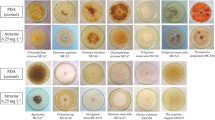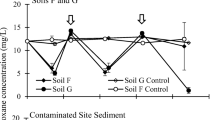Abstract
Soil microfungi belonging to the genera Aspergillus, Coniothyrium, Paecilomyces, Penicillium and Trichoderma, as well as wood-and litter-decomposing basidiomycetes, were able to degrade the explosive RDX (hexahydro-1,3,5-trinitro-1,3,5-triazine) co-metabolically, but were unable to utilize it as a sole carbon or nitrogen source. The most efficient RDX-degrading microfungi were characterized morphologically and by analysis of the ITS region of the ribosomal RNA gene cluster as Penicillium janczewskii and an unidentifiable Penicillium sp. with uniseriate phialides. Both species catalysed 80–100 % disappearance of RDX in a liquid defined medium. RDX degradation was inhibited by the presence of 30 mM NH4 + but not by 40 mM NO3 −. In basidiomycetes but not Penicillium spp., RDX degradation was greatly reduced when biomass pregrown at 23 °C was incubated with RDX at 15 °C. Because of their production of copious conidial inoculum, simple growth requirements and ability to degrade RDX at reduced temperature, Penicillium spp. show promise for the bioremediation of RDX-contaminated groundwater.
Similar content being viewed by others
References
Achtnich C, Sieglen U, Knackmuss H-J, Lenke H (1999) Irreversible binding of biologically reduced 2,4,6-trinitrotoluene to soil. — Environmental Toxicology and Chemistry 18: 2416–2423.
Akhavan J (1998) The Chemistry of Explosives. Royal Society of Chemistry, Cambridge, UK.
Axtell C, Johnston CG, Bumpus JA (2000) Bioremediation of soil contaminated with explosives at the Naval Weapons Station Yorktown. — Soil and Sediment Contamination 9: 537–548.
Bayman P, Ritchey SD, Bennett JW (1995) Fungal interactions with the explosive RDX (hexahydro-1,3,5-trinitro-1,3,5-triazine). — Journal of Industrial Microbiology 15: 418–423.
Binks PR, Nicklin S, Bruce NC (1995) Degradation of hexahydro-1,3,5-trinitro-1,3,5-triazine (RDX) by Stenotrophomonas maltophilia PB1. — Applied and Environmental Microbiology 61: 1318–1322.
Boopathy R, Gurgas M, Ullian J, Manning JF (1998) Metabolism of explosive compounds by sulfate-reducing bacteria. — Current Microbiology 37: 127–131.
Coleman NV, Nelson DR, Duxbury T (1998) Aerobic biodegradation of hexahydro-1,3,5-trinitro-1,3,5-triazine (RDX) as a nitrogen source by a Rhodococcus sp., strain DN22. — Soil Biology and Biochemistry 30: 1159–1167.
Domsch KH, Gams W, Anderson T-H (1980) Compendium of Soil Fungi I. Academic Press, London.
Etnier EL, Hartley WR (1990) Comparison of water quality criterion and lifetime health advisory for hexahydro-1,3,5-trinitro-1,3,5-triazine (RDX). — Regulatory Pharmacology and Toxicology 11: 118–122.
Fernando T, Aust SD (1991) Biodegradation of munition waste, TNT (2,4,6-trinitrotoluene), and RDX (hexahydro-1,3,5-trinitro-1,3,5-triazine) by Phanerochaete chrysosporium. In Tedder DW, Pohland FG (eds), Emerging Technologies in Hazardous Waste Management II, American Chemical Society Symposium Series 468: 214–232.
Fritsche W, Scheibner K, Herre A, Hofrichter M (2000) Fungal degradation of explosives: TNT and related nitroaromatic compounds. In Spain JC, Hughes JB, Knackmuss H-J (eds), Biodegradation of Nitroaromatic Compounds and Explosives, pp. 213–237. CRC Press, Boca Raton.
Fulthorpe RR, Schofield LN (1999) A comparison of the ability of forest and agricultural soils to mineralize chlorinated aromatic compounds. — Biodegradation 10: 235–244.
Funk SB, Roberts DJ, Crawford DL, Crawford RL (1993) Initial phase optimization for bioremediation of munition compound-contaminated soils. — Applied and Environmental Microbiology 59: 2171–2177.
Gorontzy T, Drzyzga O, Kahl MW, Bruns-Nagel D, Breitung J, von Loew E, Blotevogel K-H (1994) Microbial degradation of explosives and related compounds. — Critical Reviews in Microbiology 20: 265–284.
Grove WB (1937) British Stem-and Leaf-Fungi (Coelomycetes) II. Cambridge University Press, Cambridge, UK.
Haas R, Schreiber I, von Löw E, Stork G (1990) Conception for the investigation of contaminated munition plants. 2. Investigation of the former RDX plants and filling stations. — Fresenius’ Journal of Analytical Chemistry 338: 41–45.
Harrell-Bruder B, Hutchins KL (1995) Seizures caused by ingestion of composition C-4. — Annals of Emergency Medicine 26: 746–748.
Hawari J (2000) Biodegradation of RDX and HMX: from basic research to field application. In Spain JC, Hughes JB, Knackmuss H-J (eds), Biodegradation of Nitroaromatic Compounds and Explosives, pp. 277–310. CRC Press, Boca Raton.
Hawari J, Halasz A, Paquet L, Zhou E, Spencer B, Ampleman G, Thiboutot S (1998) Characterization of metabolites in the biotransformation of 2,4,6-trinitrotoluene with anaerobic sludge: role of triaminotoluene. — Applied and Environmental Microbiology 64: 2200–2206.
Hawari J, Beaudet S, Halasz A, Thiboutot S, Ampleman G (2000a) Microbial degradation of explosives: biotransformation versus mineralization. — Applied Microbiology and Biotechnology 54: 605–618.
Hawari J, Halasz A, Sheremata T, Beaudet S, Groom C, Paquet L, Rhofir C, Ampleman G, Thiboutot S (2000b) Characterization of metabolites during biodegradation of hexahydro-1,3,5-trinitro-1,3,5-triazine (RDX) with municipal anaerobic sludge. — Applied and Environmental Microbiology 66: 2652–2657.
Kim HY, Song HG (2000) Simultaneous utilization of two different pathways in degradation of 2,4,6-trinitrotoluene by white rot fungus Irpex lacteus. — Journal of Microbiology 38: 250–254.
Kitts CL, Green CE, Otley RA, Alvarez MA, Unkefer PJ (2000) Type I nitroreductases in soil enterobacteria reduce TNT (2,4,6-trinitrotoluene) and RDX (hexahydro-1,3,5-trinitro-1,3,5-triazine). — Canadian Journal of Microbiology 46: 278–282.
Köpcke B, Weber RWS, Anke H (2002) Galiellalactone and its biogenetic precursors as chemotaxonomic markers of the Sarcosomataceae (Ascomycota). — Phytochemistry 60: 709–714.
Kuhn A (2001) Untersuchungen zur Etablierung eines biologischen Sanierungsverfahrens mit Pilzen für sprengstoffkontaminiertes Grundwasser. Ph.D. Thesis, University of Kaiserslautern, Germany.
Levsen K, Mußmann P, Berger-Preiß E, Preiß A, Volmer D, Wünsch G (1993) Analysis of nitroaromatics and nitramines in ammunition waste water and in aqueous samples from former ammunition plants and other military sites. — Acta Hydrochimica et Hydrobiologica 21: 153–166.
Luckner L (1997) Transportverhalten organischer Stoffe in Grundwasserleitern. In: Kreysa G, Wiesner, J (eds), Möglichkeiten und Grenzen der Reinigung kontaminierter Grundwässer. Resümee und Beiträge des 12. DECHEMA-Fachgesprächs Umweltschutz, pp. 101–111. DECHEMA, Weinheim, Germany. ISBN 3-926959-80-0.
McCormick NG, Cornell JH, Kaplan AM (1981) Biodegradation of hexahydro-1,3,5-trinitro-1,3,5-triazine. — Applied and Environmental Microbiology 42: 817–823.
Michels J, Gottschalk G (1995) Pathway of 2,4,6-trinitrotoluene (TNT) degradation by Phanerochaete chrysosporium. In Spain JC (ed.), Biodegradation of Nitroaromatic Compounds, pp. 135–149. Plenum Press, New York.
Muthumeenakshi S, Goldstein AL, Stewart A, Whipps JM (2001) Molecular studies on intraspecific diversity and phylogenetic position of Coniothyrium minitans. — Mycological Research 105: 1065–1074.
Parker CE, Voyksner RD, Tondeur Y, Henion JD, Harvan DJ, Hass JR & Yinon J (1982) Analysis of explosives by liquid chromatography-negative ion chemical ionization mass spectrometry. — Journal of Forensic Sciences 27: 495–505.
Parrish FW (1977) Fungal transformation of 2,4-dinitrotoluene and 2,4,6-trinitrotoluene. — Applied and Environmental Microbiology 34: 232–233.
Pasti-Grigsby MB, Lewis TA, Crawford DL, Crawford RL (1996) Transformation of 2,4,6-trinitrotoluene (TNT) by actinomycetes isolated from TNT-contaminated and uncontaminated environments. — Applied and Environmental Microbiology 62: 1120–1123.
Pitt JI (1979) The Genus Penicillium and its Teleomorphic States Eupenicillium and Talaromyces. Academic Press, London.
Preuss J, Haas R (1987) Die Standorte der Pulver-, Sprengstoff-, Kampf-und Nebelerzeugung im ehemaligen deutschen Reich. — Geographische Rundschau 39: 578–584.
Raper KB, Thom C (1949) A Manual of the Penicillia. Bailliére, Tindall & Cox, London.
Regan KM, Crawford RL (1994) Characterisation of Clostridium bifermentans and its biotransformation of 2,4,6-trinitrotoluene (TNT) and 1,3,5-triazo-1,3,5-trinitrocyclohexane (RDX).–Biotechnology Letters 16: 1081–1086.
Rosenblatt DH, Burrows EP, Mitchell WR, Parmer DL (1991) Organic explosives and related compounds. In Hutzinger O (ed.), The Handbook of Environmental Chemistry Vol. 3 Part G, pp. 196–225. Springer-Verlag, Berlin.
Sacks W, Nürnberger T, Hahlbrock K, Scheel D (1995) Molecular characterization of nucleotide sequences encoding the extracellular glycoprotein elicitor from Phytophthora megasperma. — Molecular and General Genetics 246: 45–55.
Scheibner K, Hofrichter M, Herre A, Michels J, Fritsche W (1997) Screening for fungi intensively mineralizing 2,4,6-trinitrotoluene. — Applied Microbiology and Biotechnology 47: 452–457.
Sheremata TW, Hawari J (2000) Biodegradation of RDX by the white rot fungus Phanerochaete chrysosporium to carbon dioxide and nitrous oxide. — Environmental Science and Technology 34: 3384–3388.
Stahl JD, Aust SD (1995) Properties of a transplasma membrane redox system of Phanerochaete chrysosporium. — Archives of Biochemistry and Biophysics 320: 369–374.
Sublette KL, Ganapathy EV, Schwartz, S (1992) Degradation of munition wastes by Phanerochaete chrysosporium. — Applied Biochemistry and Biotechnology 34/35: 709–723.
Sutton BC (1980) The Coelomycetes. Fungi Imperfecti with Pycnidia, Acervuli and Stromata. Commonwealth Mycological Institute, Kew, UK.
Topp E, Zhu H, Nour SM, Houot S, Lewis M, Cuppels D (2000) Characterization of an atrazine-degrading Pseudaminobacter sp. isolated from Canadian and French agricultural soils. — Applied and Environmental Microbiology 66: 2773–2782.
Urbanski T (1984) Chemistry and Technology of Explosives, Vol. 4. Pergamon Press, Oxford, UK.
Weber RWS, Ridderbusch DC, Anke H (2002) 2,4,6-Trinitrotoluene tolerance and biotransformation potential of microfungi isolated from TNT-contaminated soil. — Mycological Research 106: 336–344.
White TJ, Bruns T, Lee S, Taylor J (1990) Amplification and direct sequencing of fungal ribosomal RNA genes for phylogenetics. In Innis MA, Gelfand DH, Sninsky JJ, White TJ (eds), PCR Protocols: A Guide to Methods and Applications, pp. 315–322. Academic Press, San Diego.
Xue SK, Iskandar IK, Selim HM (1995) Adsorption-desorption of 2,4,6-trinitrotoluene and hexahydro-1,3,5-trinitro-1,3,5-triazine in soils. — Soil Science 160: 317–327.
Yanze-Kontchou C, Gschwind N (1994) Mineralization of the herbicide atrazine as a carbon source by a Pseudomonas strain. — Applied and Environmental Microbiology 60: 4297–4302.
Author information
Authors and Affiliations
Corresponding author
Rights and permissions
About this article
Cite this article
Weber, R.W.S., Kuhn, A. & Anke, H. Soil-borne Penicillium spp. and other microfungi as efficient degraders of the explosive RDX (hexahydro-1,3,5-trinitro-1,3,5-triazine). Mycol Progress 2, 83–93 (2003). https://doi.org/10.1007/s11557-006-0047-2
Accepted:
Issue Date:
DOI: https://doi.org/10.1007/s11557-006-0047-2




